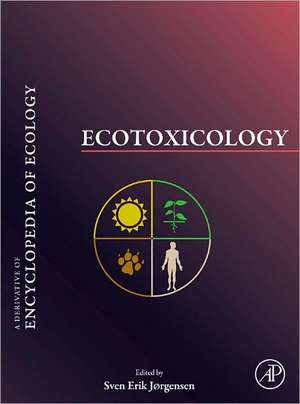Ecotoxicology
Editat de Erik Jorgensenen Limba Engleză Hardback – 30 apr 2010
- Provides an overview of the theory and application of global ecology
- International focus and range of ecosystems makes Ecotoxicology an indispensable resource to scientists
- Based on the bestselling Encyclopedia of Ecology
- Full-color figures and tables support the text and aid in understanding
Preț: 411.52 lei
Preț vechi: 447.30 lei
-8% Nou
Puncte Express: 617
Preț estimativ în valută:
78.75€ • 82.49$ • 65.26£
78.75€ • 82.49$ • 65.26£
Carte tipărită la comandă
Livrare economică 02-16 aprilie
Preluare comenzi: 021 569.72.76
Specificații
ISBN-13: 9780444536280
ISBN-10: 0444536280
Pagini: 402
Dimensiuni: 210 x 279 x 30 mm
Greutate: 1.64 kg
Editura: ELSEVIER SCIENCE
ISBN-10: 0444536280
Pagini: 402
Dimensiuni: 210 x 279 x 30 mm
Greutate: 1.64 kg
Editura: ELSEVIER SCIENCE
Public țintă
Ecologists and Ecological EngineersCuprins
Chapter 1: Introduction (New)
Chapter 2: Ecotoxicology Nomenclature
Chapter 3: Ecotoxicology: the Focal Topics
Chapter 4: Ecotoxicology: The History and Present Directions
Chapter 5: Dose-Response
Chapter 6: Body Residues
Chapter 7: Assimilative Capacity
Chapter 8: Ecological Risk Assessment
Chapter 9: Biogeochemical Approaches to Environmental Risk Assessment
Chapter 10: Acute and Chronic Toxicity
Chapter 11: Bioaccumulation
Chapter 12: Biodegradability
Chapter 13: Biomagnification
Chapter 14: Ecological Catastrophe
Chapter 15: Ecotoxicological Models of Populations, Ecosystems and Landscapes
Chapter 16: Effects of Endocrine Disruptors in Wildlife and Laboratory Animals
Chapter 17: Epidemiological Studies of Reproductive Effects in Humans
Chapter 18: Exposure and Exposure Assessment
Chapter 19: Food-Web Bioaccumulation Models
Chapter 20: Mutagenesis
Chapter 21: Reproductive Toxicity
Chapter 22: Risk Management Safety Factors
Chapter 23: Hill’s Postulates
Chapter 24: Teratogenesis
Chapter 25: Antagonistic and Synergistic Effects Antifouling Chemicals in Mixture
Chapter 26: Antibiotics in Aquatic and Terrestrial Ecosystems
Chapter 27: Benzene
Chapter 28: Copper
Chapter 29: Crude Oil, Oil, Gasoline and Petrol
Chapter 30: Dioxin
Chapter 31: Endocrine Disruptors
Chapter 32: Endocrine Disruptor Chemicals: An Overview
Chapter 33: Halogenated Hydrocarbons
Chapter 34: Lead
Chapter 35: Nitrogen
Chapter 36: Persistent Organic Chemicals
Chapter 37: Phenols
Chapter 38: Pheromones
Chapter 39: Phthalates
Chapter 40: Plutonium
Chapter 41: Polychlorinated Biphenyls
Chapter 42: Polycyclic Aromatic Hydrocarbons
Chapter 43: Radioactivity
Chapter 44: Sediment Settings, Transport, Mineralization and Modeling
Chapter 45: Synthetic Polymers
Chapter 46: Uranium
Chapter 47: Veterinary Medicines
Chapter 2: Ecotoxicology Nomenclature
Chapter 3: Ecotoxicology: the Focal Topics
Chapter 4: Ecotoxicology: The History and Present Directions
Chapter 5: Dose-Response
Chapter 6: Body Residues
Chapter 7: Assimilative Capacity
Chapter 8: Ecological Risk Assessment
Chapter 9: Biogeochemical Approaches to Environmental Risk Assessment
Chapter 10: Acute and Chronic Toxicity
Chapter 11: Bioaccumulation
Chapter 12: Biodegradability
Chapter 13: Biomagnification
Chapter 14: Ecological Catastrophe
Chapter 15: Ecotoxicological Models of Populations, Ecosystems and Landscapes
Chapter 16: Effects of Endocrine Disruptors in Wildlife and Laboratory Animals
Chapter 17: Epidemiological Studies of Reproductive Effects in Humans
Chapter 18: Exposure and Exposure Assessment
Chapter 19: Food-Web Bioaccumulation Models
Chapter 20: Mutagenesis
Chapter 21: Reproductive Toxicity
Chapter 22: Risk Management Safety Factors
Chapter 23: Hill’s Postulates
Chapter 24: Teratogenesis
Chapter 25: Antagonistic and Synergistic Effects Antifouling Chemicals in Mixture
Chapter 26: Antibiotics in Aquatic and Terrestrial Ecosystems
Chapter 27: Benzene
Chapter 28: Copper
Chapter 29: Crude Oil, Oil, Gasoline and Petrol
Chapter 30: Dioxin
Chapter 31: Endocrine Disruptors
Chapter 32: Endocrine Disruptor Chemicals: An Overview
Chapter 33: Halogenated Hydrocarbons
Chapter 34: Lead
Chapter 35: Nitrogen
Chapter 36: Persistent Organic Chemicals
Chapter 37: Phenols
Chapter 38: Pheromones
Chapter 39: Phthalates
Chapter 40: Plutonium
Chapter 41: Polychlorinated Biphenyls
Chapter 42: Polycyclic Aromatic Hydrocarbons
Chapter 43: Radioactivity
Chapter 44: Sediment Settings, Transport, Mineralization and Modeling
Chapter 45: Synthetic Polymers
Chapter 46: Uranium
Chapter 47: Veterinary Medicines











